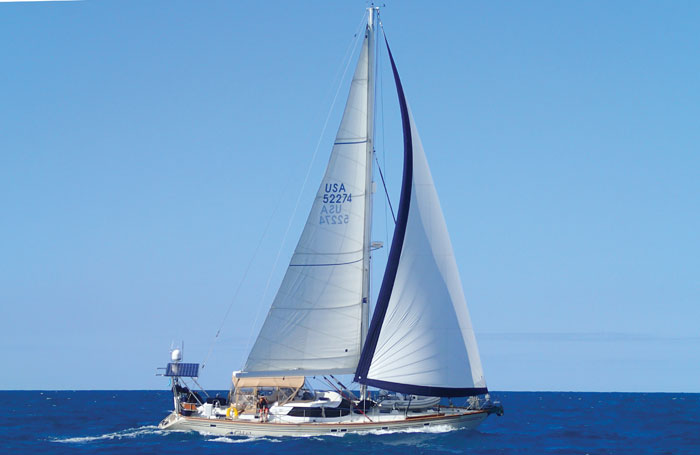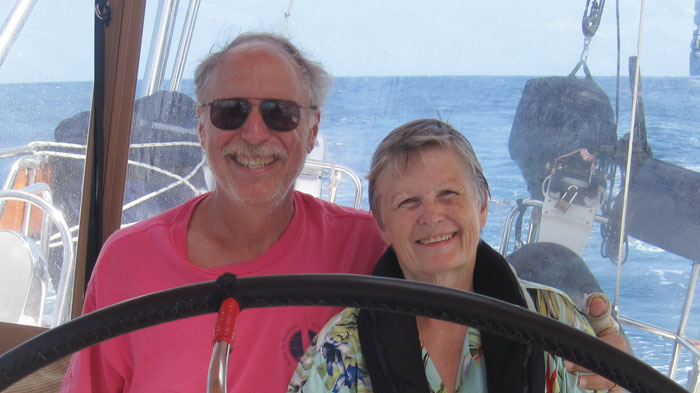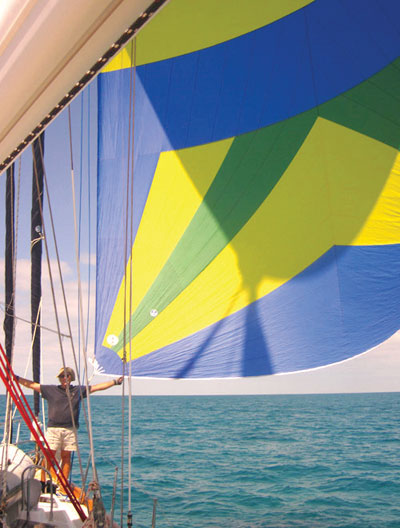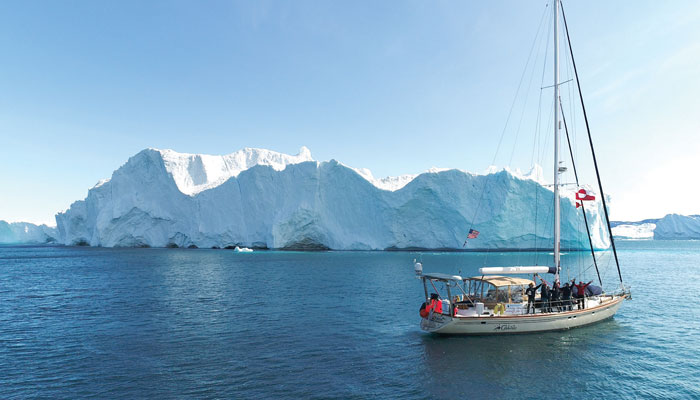How To Go From Cruising the Bay to Cruising the World
What sailor hasn’t imagined or read about the adventure of sailing offshore: The big blue water, ocean wildlife, and new cultures and landscapes waiting at the other end? For sailors with the courage, skills, and confidence to make the jump from inland sailing to the offshore scene, the rewards are many. In this final installment of our three-part series on preparing to sail offshore, we offer some guidance for cruising sailors ready to take the leap.

For expert advice we reached out to a very experienced bluewater cruising couple, Charlie and Cathy Simon, who suggest taking baby steps, gradually increasing your knowledge, skills, and experience, and in turn your level of preparation, equipment, and size of vessel.
First things first
The Simons, now world circumnavigators, have been sailing together for 40 years. Although they’ve completed many challenging passages, the couple started sailing together by enjoying day sails in Washington state and California. Now located on the East Coast, they are based in Annapolis for the sailing season and Fort Lauderdale during the winter. Since retiring 15 years ago, they’ve spent most of their time cruising, to include completion of the fabled Northwest Passage.
“When thinking about making the move to ocean cruising, two things stand out to me,” begins Charlie. “First, take baby steps, and second, if the weather isn’t good, don’t go.”
“Calendar flexibility is really important,” adds Cathy, “so that you can wait until the wind is conducive to where you want to go. When you’re cruising, there’s no point in going and beating yourself up fighting the weather. We began adjusting for the weather right from the start, well before we retired, and even now with all our experience, we still wait for good weather windows.”

It’s a marathon, not a sprint
“We got our start sailing out of Seattle and San Francisco, taking one-hour trips to an anchorage, then adding another stop a bit further,” recalls Cathy. “We often anchored under the Oakland Bay Bridge, and it was probably two years before we went outside of the Golden Gate Bridge into the Pacific Ocean. Of course, we were in the Northwest, but the Chesapeake Bay is a perfectly wonderful place to learn.”
“Build your confidence gradually,” says Charlie. “My first trip offshore, which seems small now, seemed mammoth at the time. I was in my 20s and sailed from Fort Lauderdale to Bimini in 1976.
“In our area to prepare for a short trip offshore, a weeklong cruise in the Chesapeake Bay should give you plenty of opportunity to learn a lot: what gear you need, how long your batteries hold a charge, how long the instruments last, and the best way to get a good night’s sleep.
"At that point, you may be ready for the next step: a short trip offshore. There you’ll find out more about your boat and whether you get seasick.” As you continue to take the next step and the next, you may need or want a bigger boat. “Although people do it, I wouldn’t recommend going offshore in anything smaller than a 40-foot boat,” says Charlie.
Cathy explains that their own progression as sailors naturally led to owning bigger boats: “We started on a 33-footer in San Francisco Bay. Then for coastal cruising we moved up to a 46-foot boat. Our current boat, Celebrate, is a 58-foot Taswell yacht designed for bluewater. It can handle a range of conditions, provides the speed we desire, and has a big generator.”

Equipment and preparation level grow with your experience level
As your confidence grows and you sail farther, be preparing to go farther in the future. Bigger boats mean bigger preparation. “Early on your shakedown cruise might be done in the Bay or circumnavigating the DelMarVa, but with each step you’ll be preparing go farther next time,” says Charlie. “And as your trips become longer, your preparation level will grow too. Our shakedown cruise with our 58-foot vessel was to Nova Scotia.”
“You will likely make a progression something like this: coastal cruising or a DelMarVa rounding, a passage to Bermuda, and then maybe a trip around the world, as we did. As you would expect, our Arctic trip took the most preparation of all. But for a 50- to 100-mile trip, preparation isn’t too much of a problem. With each new step, you will add to your boat,” says Charlie.
Among the equipment and gear needed to get started are: good offshore life jackets, jack lines and tethers, a dinghy or life raft, ditch kit, auto helm, charts (electronic and paper), a range of clothing (it’s colder on the ocean, even in summer), flares (you will need leather gloves and goggles to deploy the flares), and reliable communication and radar, such as a SAT phone and AIS. Add more equipment as you go farther. You may eventually need to upgrade your life raft, add a cockpit enclosure, add a freshwater maker, and more.
“Make safety gear a habit,” suggests Cathy. “And remember that being comfortable goes a long way toward good safety because you need to stay warm, well rested, and well fed to make better decisions. Also, even for a 50 to 100-mile trip, take spares of many safety items.”
“AIS will be important,” says Charlie, “especially at the mouth of the Bay. Other technology that helps is unlimited data with Garmin, and for email, SailMail, which maintains email communications in oceans all around the world. A SAT phone is a must for downloading weather information offshore. I check the weather first thing every morning, but the key is to talk to the local expert where you are, who knows the area and has experience routing boats there. They bring a lot to the table that you can’t read on your own.”

Have fun every time
“Take a slow approach and have fun every time you sail, so that you want to go out more,” says Cathy. “Sailing is supposed to be fun. With racing you have regulations, but with ocean cruising you go to a sunny spot, and when the weather is good, you go on to the next sunny spot. For us ocean sailing has been a wonderful adventure, and it can last a lifetime—I will be 70 this year, and we’re still having a great time.”
Read more about preparing to sail offshore in parts one and two of this series.
For more articles about cruising, click here.




